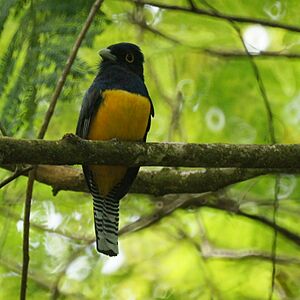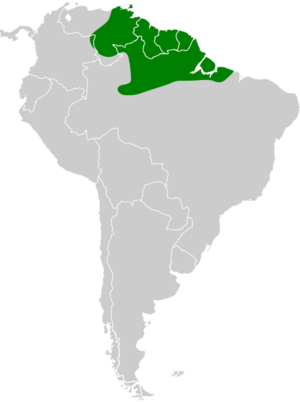Guianan trogon facts for kids
Quick facts for kids Guianan trogon |
|
|---|---|
 |
|
| Scientific classification | |
| Genus: |
Trogon
|
| Species: |
violaceus
|
 |
|
The Guianan trogon (Trogon violaceus) is a beautiful bird from the trogon and quetzal family. It lives in warm, tropical areas. You can find this bird in countries like Brazil, French Guiana, Guyana, Suriname, Trinidad, and Venezuela.
Contents
About the Guianan Trogon's Name
The Guianan trogon got its official name in 1788. A German scientist named Johann Friedrich Gmelin described it. He gave it the scientific name Trogon violaceus. The word violaceus comes from Latin. It means "violet-coloured," which describes some of the bird's beautiful feathers.
For a long time, this bird was known as the violaceous trogon. It was thought to be the same species as two other trogons. These were the gartered trogon and the Amazonian trogon. But scientists later studied these birds more closely. They found that the Guianan trogon is actually its own unique species. So, it is now considered a separate kind of bird.
What Does the Guianan Trogon Look Like?
The Guianan trogon is a medium-sized bird. It is about 23 to 25 centimeters (9 to 10 inches) long. It weighs between 38 and 57 grams (1.3 to 2 ounces). Male and female Guianan trogons look quite different.
Male Guianan Trogons
Adult males have a striking violet-blue head. They have a black mask around their eyes and a black throat. Their beak is a pale blue-gray color. Around their dark eyes, they have bare, pale yellow skin. The violet-blue color from their head extends down to their chest. A thin white band separates this blue from their bright yellow belly. Their upper body is a shiny metallic green. Their wings look dark gray-brown. This is because they have very fine black and white markings. Their tail is violet-blue on top with black tips. The underside of their tail has fine black and white stripes. It also has wide white tips on the feathers.
Female Guianan Trogons
Adult females have a blackish upper beak. Their face has white arcs above and below their eyes. Their head and upper body are dark gray. Their wings have thin but dense black and white stripes. Their belly is a duller yellow than the male's. It also has a gray wash on its sides. The underside of their tail looks striped on its sides.
Young Guianan Trogons
Young male trogons have browner wings. They also have less white on the underside of their tail than adult males. Young female trogons look similar to adult females.
Guianan Trogon Sounds
The Guianan trogon has a special song. It is a long series of fast, hollow, whistling sounds. It sounds like "kyu-kyu-kyu-kyu-kyu-kyu." They also make "rolling chattering" calls.
Where Do Guianan Trogons Live?
Guianan trogons do not migrate. This means they stay in the same area all year round. You can find them in eastern Venezuela and the Guianas. They also live in nearby northern Brazil.
These birds live in many different kinds of open areas. They like savannas, which are grassy plains with scattered trees. They also live at the edges of thick forests. You can find them in new forests that are growing back. They also like cacao and coffee farms. Sometimes, they live in higher areas, up to 1,200 meters (about 3,900 feet) high in Venezuela.
Guianan Trogon Behavior
What Do Guianan Trogons Eat?
The Guianan trogon eats mostly fruit and insects. They catch their food by hovering in the air. They fly out from a perch for a short time to grab their meal. These birds often join groups of different bird species that are looking for food together.
Reproduction and Life Cycle
The breeding season for the Guianan trogon is not fully known. But it seems to be between November and June. These birds make their nests by digging a hole. They often dig into the nests of paper wasps, ants, or termites that are in trees. They also use rotten wood or fern root masses.
A female Guianan trogon usually lays two or three eggs. Scientists do not know exactly how long the eggs take to hatch. But the young birds leave the nest at least 17 days after they hatch.
Guianan Trogon Status
The Guianan trogon is not assessed separately by some groups. This is because they still consider it part of a larger group of violaceous trogons. In Venezuela, this bird is rare and found only in certain places. But in Trinidad and Suriname, it is quite common.

